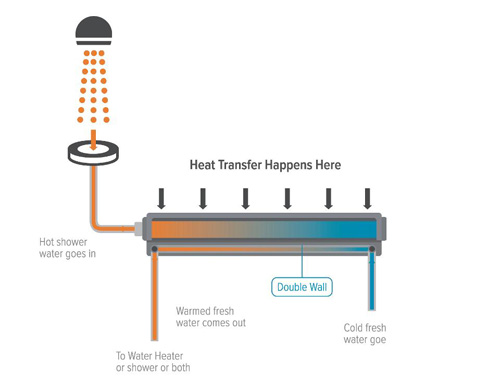Water heating accounts for approximately 20 to 30 percent of household energy demand. Much of the energy is expended warming the water coming into the shower and other areas of the house. By transferring some of the heat from the drain water to the incoming water through a heat exchanger, reduced energy is required. A significant portion of the heat from the drainwater is efficiently transferred to the incoming water with no energy use. By reducing the demand on the water heater, this also allows for increased capacity of the tank.
This is achieved by a variety of systems called Drain Water Heat Recovery (DWHR). As warm water flows from your shower down the waste drain on its way to sewer, the DWHR device uses heat exchange to transfer the heat to an incoming flow of cold water headed towards the water heater.
These systems generally work on tank water heaters as well as on-demand ones. They are particularly popular in Canada and northern areas of the United States where the ground water is very cold.
DWHR systems are gaining in popularity because water heating uses so much of the household energy. According to Canada Mortgage and Housing Corporation (cmhc.ca ). “Although this technology adds to the capital cost of construction projects, the energy savings over the life of the building help make it an ideal application for affordable housing projects.” Since the cost can be recouped in a short amount of time, it would seem logical that all houses be equipped with this type of system. These systems have no moving parts, a long life, and require minimal maintenance.
All DWHR systems can be easily installed by any licensed plumber or experienced handyperson. It is easiest to install these systems when the house is being built but they can be installed on remodels. Because they save so much on energy they add value to the home which is always a plus when selling the house. For those seeking LEED for Homes certification, they can achieve points for these  systems under the efficient hot water equipment credits. DWHR systems are currently being installed in Passive Houses, where keeping energy to a minimum is a major factor.
systems under the efficient hot water equipment credits. DWHR systems are currently being installed in Passive Houses, where keeping energy to a minimum is a major factor.
There are several systems currently on the market that recover heat from household water. Both of the systems mentioned here can be installed at specific shower locations or at the bottom of the home’s main drain stack, where it can recycle the energy from all the showers in the floors above.
The two most popular systems in North America are the EcoDrain™ and Power-Pipe® by RenewABILITY Energy Inc., which both feature patent-pending technologies.
The typical DWHR device will range from 32 inches in length up to 72 inches. Longer units provide higher rates of heat recovery, but be sure to look at rated performance to compare different models or brands. Natural Resources Canada has a website that allows just such a comparison.
Various places around North America such as Ontario and Manitoba, Canada require these systems be installed in new homes.These systems can be used to achieve building energy requirements or credits in the State of Washington, the State of California, and some parts of British Columbia. And there are rebate programs in other jurisdictions. They are currently being used in single family homes but are beginning to be used in multi-family units to cut energy costs.
I discovered these systems in various houses I have written about over the years and believe it is a simple and practical way of saving energy, preserving the water heating system and expanding the hot water availability in the home.
by Sheri Koones





Leave a Reply
Want to join the discussion?Feel free to contribute!